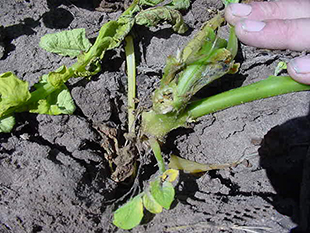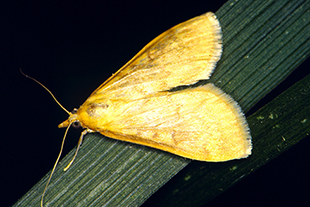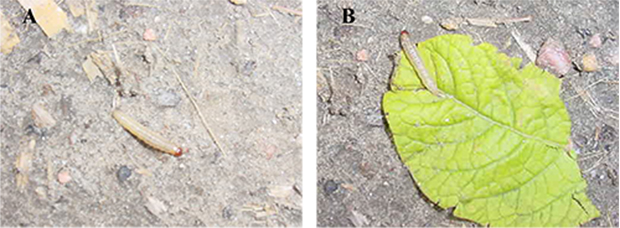G2229
European Corn Borer on Potato
European corn borer can move from corn to irrigated potato fields, and can introduce and spread bacteria that cause black leg and tuber soft rot. Insecticides can help control larvae and adults.
Alexander D. Pavlista, Potato Specialist
- Injury to Potato by European Corn Borers
- What Do European Corn Borers Look Like?
- How Are European Corn Borers Monitored?
- How Can European Corn Borer Be Controlled?
- Quick Review
The European corn borer (Ostrinia nubilalis) first appeared in Nebraska in the 1940s. Infestations are observed primarily in the eastern half of the state. With the widespread use of Bt corn, this insect is no longer a major problem on corn, its primary host, but it has many hosts in Nebraska such as members of the Solanaceae family which includes potato, tomato, and pepper. Furthermore, insecticides in the imidacloprid family do not affect European corn borer. As a result, this insect is observed increasingly in potato fields east of North Platte. Commonly, the borer moves into potato fields from corn fields when the weather becomes very dry and female moths search for a moist environment to deposit eggs, such as an irrigated potato field. European corn borer overwinters in cornstalk debris as larva.
Injury to Potato by European Corn Borers
Looking across a potato field, the first indication of corn borer infestation is seeing plants with rolled green leaves at the top (Figure 1). This symptom can be associated with many diseases and insect infestations; therefore, approach the plant and look closely to determine whether it is due to European corn borer. In the lower third of the stem or branch, a small hole, probably with frass (insect excrement) around it, will be observed if the leaf roll is due to the corn borer (Figure 2). Frass is tan-colored and grainy like fine sand. Splitting the stem will often uncover the larva responsible (Figure 3). On occasion the pupa will be found. Since young larva may make several tunnels, it may not be observed. Young larvae tend to feed mostly in the upper canopy and leave their frass along the leaflet axil. Older larvae, later instar, bore deep into the branch base. The hole in the stem is the entrance to a small tunnel into the center of the stem tissue bored by the larvae of the corn borer. In the process of the larva eating out the pith of the stem, it also eats the vascular tissue, disrupting nutrient flow and resulting in leaf roll and wilt. The more damaging effect of these tunnels is that bacterial and fungal pathogens can enter directly into the potato plant. The most important of these are Pectobacterium spp. that cause black leg and soft rot (see NebGuide G2203, Wet Rots of Potato in Storage).
 |
 |
|
Figure 1. Potato leaf curl due to European corn borer |
Figure 2. Entry hole in potato stem from European corn borer |
|
 |
 |
|
Figure 3. Mature European corn borer larva in potato stem |
Figure 4. Adult, female European corn borer (moth) |
Yield losses from European corn borer alone are rare, and when observed, occurred due to a heavy early-season, pre-bloom infestation by the first generation and not from later infestations. For a significant economic loss, infestation would need to include at least 20 percent of plants.
What Do European Corn Borers Look Like?
Adult moths are susceptible to control measures but are not damaging to potato. They are shaped triangularly when not flying and are about three-quarter inch long along their axis (Figure 4). Wings appear straw colored, but males and females vary somewhat in their coloration. Females appear creamy to pale yellow to light brown and have a stout body, while male bodies are smaller and more slender, with wings that are darker than females. The adult wingspan is about 1 inch and about one-half inch wide when at rest. The outer third of the wings are marked by two dark, serrated lines running across the wing.
Adults lay eggs that are smaller than a pin head. Eggs are white or creamy then turn pale yellow and finally darken with a “black head” just before hatching (Figure 5A and B). Eggs are deposited on the underside of leaves in masses of 20 to 30. The eggs in the mass overlap, giving a fish-scale type of appearance. An egg mass is one-eighth to three-sixteenth of an inch long. A female adult lays 200 to 500 eggs at a rate of 24 to 40 per day for 14 to 21 days. The eggs hatch in three to 12 days depending on temperature.
 |
Figure 5. European corn borer egg masses: A. white stage, B. black-head stage |
 |
Figure 6. Young European corn borer larvae |
|
The damaging stage of European corn borer are the larvae. They are light gray to faint pink with a brown to black head and have small brown to black spots along the sides of each segment and a faint stripe along the back (Figure 6A and B). The body is worm-like or capsule-shaped and segmented with legs. They grow to about 1 inch. Larvae are usually found burrowed into potato stems. Larvae change to pupae in a chamber burrowed into the stem (Figure 7). Pupae are smooth, reddish-brown, cylindrical, and about one-half inch long.
How Are European Corn Borers Monitored?
The primary strain in Nebraska has two generations per season, although in western Nebraska a second one-generation strain also is present. Fully grown larvae overwinter in cornstalk residue usually, and metamorphize to pupae in the spring as the soil warms to above 50°F. After about two weeks, adults emerge, and after two or three weeks, eggs are laid and hatch a week later, releasing larvae, which damage plants during the month before they pupate.
Larvae feed on foliage and bore into the stem, feeding on the inside. Across Nebraska, the first generation of adults appears in late May to mid-June, and damage to potato plants appears toward the end of June to mid-July. The second-generation adults appear toward the end of July with larval damage appearing in August. The larvae of this generation overwinter. The first generation is normally the problem, but the second generation can reduce tuber bulking and cause storage damage by introducing wet rot pathogens in the field. Adults of the univoltine strain appear in early July, and their activity is between the two generations of the two-generational population.
At night, adult female European corn borers, especially in dry seasons, search for lush plants in irrigated fields. Potato, with its dense canopy and ability to hold moisture, suits them perfectly. Once in the potato field, female moths will lay eggs, foregoing their favorite host for a good water supply.
European corn borer activity can be detected by monitoring adults using blacklight or pheromone traps. Blacklight traps are monitored by University of Nebraska Extension personnel and often reported on the Entomology Department’s websites. Moths may be “flushed up” by walking through the field. As moth activity increases, potato stems should be examined for entry holes. If the number of corn-borer-infested stems exceeds 20 per 100 stems sampled, an insecticide application may be warranted. In general, the economic threshold is reported as 20 percent of plant stems infested.
How Can European Corn Borer Be Controlled?
Insecticides are used to suppress the larva of the European corn borer; therefore, to be effective, treatments must be applied before larvae tunnel into the stem. Young larvae feeding on the top of the canopy and tunneling repeatedly also may be affected. But older larvae tunnel deep into the stem and stay there. Scouting for the second generation on potato can be done using traps, as with the first, but it is best to also look for egg masses on the underside of potato leaflets.
Broad-spectrum foliar insecticides are effective in killing European corn borer. Pyrethroids labeled for potato are commonly applied and include permethrin (Ambush®, Pounce®), esfenvalerate (Asana®), and cyfluthrin (Baythroid®). Chemical treatment should begin about a week after peak moth flight in corn, and a second application made one week to 10 days later. Rarely are more than two applications needed. As long as the initial insecticide application is made at the beginning of the infestation episode, even if some young larvae have penetrated the plant, the overall infestation will be greatly reduced. Young larvae can move around, making several holes for a week or so before tunneling deep into the stem and staying there. In-furrow systemic insecticides will NOT seriously affect European corn borers in potato. Biological control by predators introduced from Europe is spotty. Ladybird beetles are predators of borer eggs as well as eggs of Colorado potato beetle, and ladybeetle population should be encouraged before applying insecticides that would harm them.
This publication has been peer reviewed.
DisclaimerReference to commercial products or trade names is made with the understanding that no discrimination is intended of those not mentioned and no endorsement by University of Nebraska–Lincoln Extension is implied for those mentioned. |
Visit the University of Nebraska–Lincoln Extension Publications website for more publications.
Index: Insects & Pests
Field Crop Insects
Issued February 2014
